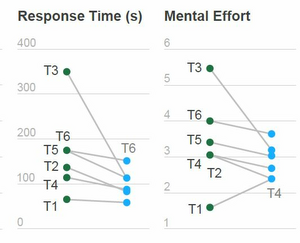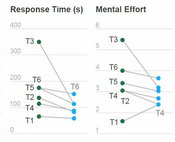Information
- Publication Type: Journal Paper (without talk)
- Workgroup(s)/Project(s):
- Date: October 2021
- DOI: 10.1109/TVCG.2021.3119212
- Journal: IEEE Transactions on Visualization and Computer Graphics
- Open Access: yes
- Pages: 1 – 15
Abstract
Spreadsheet-based tools provide a simple yet effective way of calculating values, which makes them the number-one choice for building and formalizing simple models for budget planning and many other applications. A cell in a spreadsheet holds one specific value and gives a discrete, overprecise view of the underlying model. Therefore, spreadsheets are of limited use when investigating the inherent uncertainties of such models and answering what-if questions. Existing extensions typically require a complex modeling process that cannot easily be embedded in a tabular layout. In Fuzzy Spreadsheet, a cell can hold and display a distribution of values. This integrated uncertainty-handling immediately conveys sensitivity and robustness information. The fuzzification of the cells enables calculations not only with precise values but also with distributions, and probabilities. We conservatively added and carefully crafted visuals to maintain the look and feel of a traditional spreadsheet while facilitating what-if analyses. Given a user-specified reference cell, Fuzzy Spreadsheet automatically extracts and visualizes contextually relevant information, such as impact, uncertainty, and degree of neighborhood, for the selected and related cells. To evaluate its usability and the perceived mental effort required, we conducted a user study. The results show that our approach outperforms traditional spreadsheets in terms of answer correctness, response time, and perceived mental effort in almost all tasks tested.Additional Files and Images
Weblinks
- Entry in reposiTUm (TU Wien Publication Database)
- Entry in the publication database of TU-Wien
- DOI: 10.1109/TVCG.2021.3119212
BibTeX
@article{Dhanoa_2021,
title = "Fuzzy Spreadsheet: Understanding and Exploring Uncertainties
in Tabular Calculations ",
author = "Vaishali Dhanoa and Conny Walchshofer and Andreas
Hinterreiter and Eduard Gr\"{o}ller and Marc Streit",
year = "2021",
abstract = "Spreadsheet-based tools provide a simple yet effective way
of calculating values, which makes them the number-one
choice for building and formalizing simple models for budget
planning and many other applications. A cell in a
spreadsheet holds one specific value and gives a discrete,
overprecise view of the underlying model. Therefore,
spreadsheets are of limited use when investigating the
inherent uncertainties of such models and answering what-if
questions. Existing extensions typically require a complex
modeling process that cannot easily be embedded in a tabular
layout. In Fuzzy Spreadsheet, a cell can hold and display a
distribution of values. This integrated uncertainty-handling
immediately conveys sensitivity and robustness information.
The fuzzification of the cells enables calculations not only
with precise values but also with distributions, and
probabilities. We conservatively added and carefully crafted
visuals to maintain the look and feel of a traditional
spreadsheet while facilitating what-if analyses. Given a
user-specified reference cell, Fuzzy Spreadsheet
automatically extracts and visualizes contextually relevant
information, such as impact, uncertainty, and degree of
neighborhood, for the selected and related cells. To
evaluate its usability and the perceived mental effort
required, we conducted a user study. The results show that
our approach outperforms traditional spreadsheets in terms
of answer correctness, response time, and perceived mental
effort in almost all tasks tested. ",
month = oct,
doi = "10.1109/TVCG.2021.3119212 ",
journal = "IEEE Transactions on Visualization and Computer Graphics",
pages = "1--15",
URL = "https://www.cg.tuwien.ac.at/research/publications/2021/Dhanoa_2021/",
}


 Image
Image Paper
Paper
